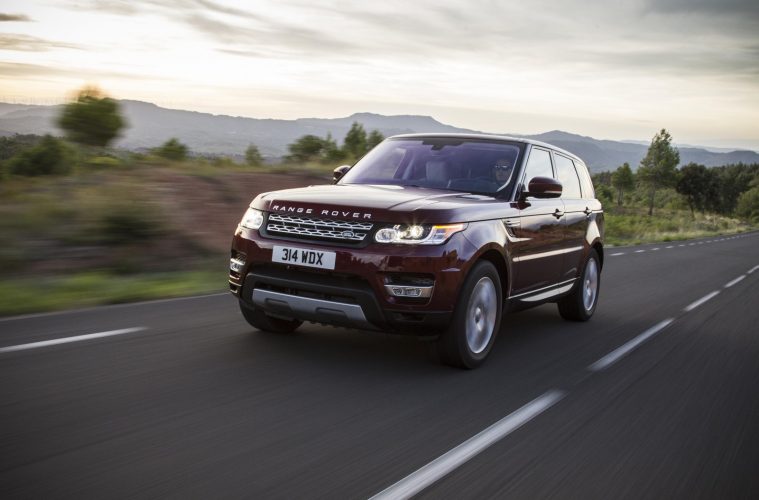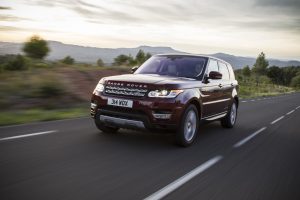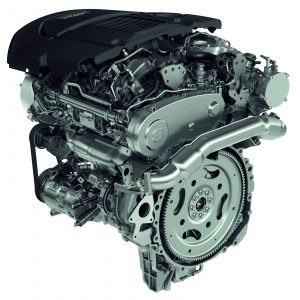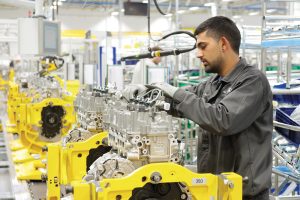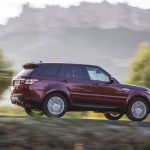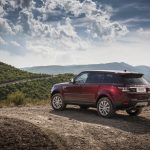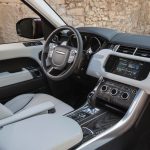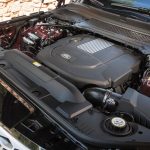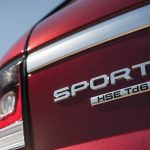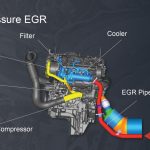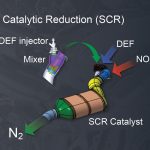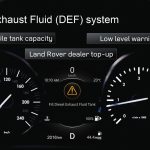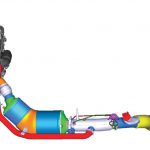It’s been a long time coming,” sang Sam Cooke, “but a change is gonna come.” Hello, US Land Rover enthusiasts, welcome the new Td6 diesel engine to our shores.
The last diesel Land Rover officially came to the US in 1966, in the guise of the 2.25 62 hp 4-cylinder engine, a motor first offered with the creation of the Series II-A in 1961. In between, Land Rover engineered a series of improved diesel engines whose smoothness, power and drivability made them so popular, that Land Rover essentially removed the V-8 petrol engine from all but the US and Middle East markets.
Diesel engines do offer some tremendous advantages, especially for off-road and adventure travel. They fire up because of compression, not spark, thus they’re virtually unaffected by water. Those photos of Camel Trophy Land Rovers fording rivers up to their windshields? Diesels at work. Diesel fuel packs 20-40% more energy than gasoline. This ensures vastly improved fuel mileage and range while producing high torque at low rpms. The same build quality that can withstand compression ratios nearly twice that of petrol engines means that well maintained diesel engines have a life of several hundred thousand miles. What’s not to love?
Land Rover enthusiasts have drooled over the 200 tdi, 300 tdi, Td5, Puma and other Land Rover diesel options for decades. Even before the Volkswagen debacle, diesels had been a tough sell for all manufacturers in the US market, comprising only 3% of new car registrations. (Compare that to the UK, where diesels hold 50% of the market.)
Historically, fuel economy has played a smaller role in vehicle purchases here. Despite occasional [and painful] price spikes, the US enjoys gas prices far lower than that those of Land Rover’s larger export markets; our British friends pay nearly $8 per gallon.
Then, of course, we must remember the epic fail of the General Motors diesels in the late ‘70s and early ‘80s. By 1981, Popular Mechanics listed common problems of “ruined injection pumps and injectors, worm cams and valve lifters, cracked engine blocks and even broken crankshafts.” Combined with the lower quality diesel fuels common at the time, diesel cars seemed to spew out black smoke with abandon. Lower-quality diesel fuel meant that the fuel would gel in cold weather; some owners of Mercedes diesels would leave them running overnight in the winter. Only the most avid diesel fans overlooked those early vehicles; most Americans simply ignored them. Now NHTSA has upped the CAFÉ fuel goals and the EPA has set high standards for diesel emissions. Adding diesel engines to the US model lineup required a significant commitment on the part of Land Rover.

Dharam Nayear, Senior Manager of Diesel Calibration and Controls for Jaguar Land Rover
Dharam Nayear, Senior Manager of Diesel Calibration and Controls for Jaguar Land Rover, gave Rovers Magazine a behind the scenes overview. Like many of the Land Rover UK executives and managers we’ve met, he’s put considerable time in with Land Rover; in his case, he started at Land Rover 27 years ago as a powertrain apprentice. During this period he’s worked on powertrain test facilities, business planning for JLR powertrain with Ford for 4 years and returned to Land Rover focusing on emissions and OBD [on board diagnostics]. For the past two years he’s been responsible for all the diesel calibration functions of both Land Rover and Jaguar. “When you consider the challenges we have as a collective set of brands, the team’s enthusiasm and motivation are just amazing.”
Land Rover had to meet many challenges in adapting their diesel engine to meet US regulations. Dharam noted, “The EU and US regulations are much closer than they were five years ago, but in some ways, the North American legislation is much stricter. We know we have the best emission control strategies for the EU, but the US and Canada have very different environmental conditions that must be considered. There are extremes of temperature, from very hot to very cold, as well as extremes in altitude, from sea level to mountains. Your vehicles also spends a lot of time in congested cities, with low load, low speed and a lot of idling.”
“Our powertrain engineering and validations needed to be robust; we couldn’t just set the calibrations in the UK and import those vehicles into the US. We’ve been working on this product for the past three and half years. We’ve even had a fleet of vehicles in five states for 10 months, covering over 900,000 miles, focusing on differences in temperature, altitude, and driving conditions, urban and rural.”
The Td6 dates back to 2003, at first a 2.7 liter with a single turbo in Land Rover applications and a twin turbo in Jaguars. One British road test considered it “tedious and slow” in the Range Rover. Contemporary road tests listed performance figures of 174 hp at 4000 rpm, with 287 ft. lbs. of torque at 2000 rpm. Land Rover kept enhancing the engine; for the 2010 model year Land Rover upped the displacement to 3.0 liters with a new turbo unit, a Bosch high pres- sure injector system and twin, high pressure EGR units.
For 2016, this diesel delivers 440 ft. lbs. of torque at 1,750 rpm and 254 hp (the gasoline V6 produces 332 ft. lbs. at 3,500 rpm). Land Rover North America cites the benefits this provides for “towing heavy loads and off-roading, where reaching maximum torque at lower gear is extremely beneficial.” Similarly, the low-end torque of the Td6 allows the vehicles to deliver 0-60 acceleration, comparable to the higher horsepower V6 gasoline models. The Range Rover Sport HSE Td6 and Range Rover HSE Td6 accelerate from 0-60 mph in 7.1 and 7.4 seconds respectively, compared to 6.9 and 7.1 seconds for gasoline V6 models.
“For the 2016 diesels we introduced low pressure EGR, a revised fuel injection system with new injection nozzles, additional sensors to meet CARB’s OBD II legislation, a higher capacity fuel pump, switchable oil and water pump [on and off, depending on engine requirements] and new radiators. Together these enable us to meet the EPA and CARB emission standards. We’ve been EPA-certified as 29 mpg highway and 25 mpg combined for the Range Rover models.”
Dharam noted that the Td6 could not achieve its performance goals without the significant weight reductions of the aluminum-based architecture of the new Range Rovers. “The weight reduction was prime in delivering the experience we wanted, in terms of power and drivablility. It was key to deliver the attributes expected by our customers. Land Rover enthusiasts expect their vehicles to perform at the highest levels off-road, and those demands claimed equal attention for Dharam’s team. “We have to meet all emissions requirements in off-road conditions, too. Land Rovers must achieve their 45 degree ascent and 35 degree side slope goals. The hardware must work in all those conditions, as well as deep-water wading, mud, dust and water ingress. We have torque targets keyed to throttle pedal response, and that was our hardest challenge.”
There’s a lot of clever technology that goes into designing and producing this Land Rover diesel. The block utilizes Compacted Graphite Iron (CGI) over cast iron or aluminum because of its greater tensile strength and added stiffness, lower weight and reduced overall size. The deep-skirted, cross-bolted design and one-piece structural aluminum oil sump of the Td6 help the engine to absorb combustion noise. Prior to its introduction in the US, prior improvements included a water-cooled turbocharger for maximum performance and durability at high operating temperatures, and new ball bearings, vanes and nozzles to improve efficiency.
A Selective Catalytic Reduction (SCR) system uses Diesel Exhaust Fluid (DEF) to reduce NOx emissions, ensuring the Td6 achieves US LEV 3 status. The DEF is injected into the exhaust and, as the resulting mixture passes through the SCR, NOx is turned into harmless nitrogen gas. The easily-accessed reservoir for the DEF holds enough fluid for approximately 10,000 miles. Land Rover uses generally available diesel exhaust fluid and owners can top it off themselves.
Under the hood, a new Low Pressure EGR system reduces emissions while improving fuel economy. Unlike traditional High Pressure EGR systems, which recirculate gases directly from the exhaust manifold to inlet manifold at high pressure, the revised design takes gases at low pressure—after the DPF filter in the exhaust pipe—and feeds them back to the turbocharger inlet. From here they pass through an intercooler, resulting in a lower peak combustion temperature. The higher the peak combustion temperature, the more NOx is produced, so the low pressure EGR system has the effect of reducing the level of NOx produced by lowering the peak combustion temperature and improving efficiency. Also, revised fuel injectors employ a two-stage process to eliminate the common “diesel knock.”
For the Range Rover diesel models, Land Rover created new engine mounts, acoustic laminations for windshields and revisions to the bulkhead to further reduce engine noise and vibration. Lastly, the filler neck size reduces the chance of an inattentive owner filling up with gasoline instead of diesel.
At this time the Td6 engine is built at the JLR plant in Dagenham, but as Land Rover moves to include the Ingenium engine into all US models, production will shift to the new Wolverhampton plant. Maria Rodriguez of Land Rover North America told us she visited that plant recently and found it “Amazing to see. It’s highly robotic and efficient, and it will help Land Rover bring the Ingenium engine into all of our models.”
Land Rover’s diesels, now and in the future, will come under strict scrutiny given the debacle of Volkswagen’s use of “defeat devices” to increase emissions beyond legal limits. Stuart Schorr, Vice President of Communications and Public Affairs stated, “Customers who buy vehicles from Jaguar Land Rover can be confident that they will be fully compliant with all EU and US emissions regulations. All Jaguar Land Rover EU6 diesel engines are equipped with Diesel Particulate Filters (DPF) and Selective Catalytic Reduction (SCR).”
Although the number of diesel Land Rovers imported this model year will be small, Land Rover dealers have responded positively to their arrival [see sidebar]. Land Rover has stated that the diesel engine option will work its way into every US model, and that we’ll see the newer 2.0 Ingenium engine in the future. Enthusiasts can’t wait to take them off-road.
Land Rover Dealer Impressions
JoHanna Hoehn, General Manager
Land Rover Carlsbad, CA
“I drove the Range Rover Sport for the first time today. I thought it was great. I couldn’t tell a difference! The only people who might not want to migrate to the diesel are those who currently have the supercharged V8.”
“I think the stigma [against diesels] is starting to change. People thought they were dirty and noisy, but that’s not the case. At the Rallye des Gazelles in Morocco [see Spring 2015 issue], we were just one of a handful of competitors running a petrol engine, so we were in constant danger of running out of gas. We had an extra fuel tank installed; some of the FJ Cruisers just made it.”
“We have signed up for next year and I think a diesel Range Rover would be a great choice—but we have only two in stock, so it would be hard to pull one out for prep.”
Rick Nelson, Special Events and Marketing Manager
Land Rover Las Vegas, NV
“During the summer, the dealership had a presentation by Land Rover North America on the evolution of the diesel in the US market. He re- minded us of the ‘80s diesels of Mercedes and General Motors, with their manual glow plugs, slow warm up, soot and fuel issues. Obviously there have been huge improvements. This Td6 felt just like the V-6 petrol to me, very quiet and comfortable. I just gave back my 2014 Range Rover and this new model feels so similar, but the diesel’s fuel mileage would save me $100 a month because of 32% increase in fuel mileage. And for off-roading, you can’t beat the 440 ft-lbs of torque! It’s going to be my next Range Rover.”
Jorge Figueroa, General Manager
Land Rover Princeton, NJ
“I’ve just had the opportunity to drive one for an extended time; it’s been difficult because the Range Rovers get sold the moment they arrive at the dealership.”
“I test drove one when Land Rover North America made them avail- able for a day at each dealership. The torque was incredible and it sounded fabulous, not a loud, clanky thing at all. Inside the Range Rover is very quiet and vibration-free. I know they’ve been equipping Range Rovers with diesels in Europe for a long time and they’re very popular, especially for people who tow boats or trailers.”
“We’ll have to help customers understand the different service cycle on the emissions system, but otherwise, they just won’t experience any difference.”
Jeff Johnson, General Manager
Land Rover Charlotte, NC
“The power is fantastic, over 400 ft-lbs in the Range Rover. We have one now as ours sales demonstrator; otherwise, I wouldn’t have one to show at all! I’m very excited; I’ve been with the brand since 1999, when we had only two models to sell. This is a terrific addition to the Land Rover lineup.”
Matt Bigelow, General Manager, and Katherine “Tink” Doyle,
Sales Guide, Land Rover Richmond, VA
“You can’t tell it’s a diesel from the inside of the Range Rover. It’s a very quiet, very powerful drive in either the Range Rover or Range Rover Sport. We’re selling them to customers already.”
By Jeffrey Aronson
Photos: Land Rover Media, Jeffrey Aronson
